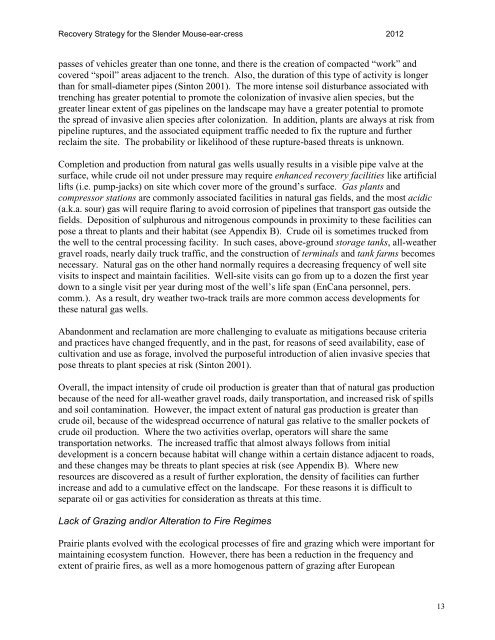Slender Mouse-ear-cress (Halimolobos virgata)
Slender Mouse-ear-cress (Halimolobos virgata)
Slender Mouse-ear-cress (Halimolobos virgata)
Create successful ePaper yourself
Turn your PDF publications into a flip-book with our unique Google optimized e-Paper software.
Recovery Strategy for the <strong>Slender</strong> <strong>Mouse</strong>-<strong>ear</strong>-<strong>cress</strong> 2012<br />
passes of vehicles greater than one tonne, and there is the creation of compacted “work” and<br />
covered “spoil” areas adjacent to the trench. Also, the duration of this type of activity is longer<br />
than for small-diameter pipes (Sinton 2001). The more intense soil disturbance associated with<br />
trenching has greater potential to promote the colonization of invasive alien species, but the<br />
greater lin<strong>ear</strong> extent of gas pipelines on the landscape may have a greater potential to promote<br />
the spread of invasive alien species after colonization. In addition, plants are always at risk from<br />
pipeline ruptures, and the associated equipment traffic needed to fix the rupture and further<br />
reclaim the site. The probability or likelihood of these rupture-based threats is unknown.<br />
Completion and production from natural gas wells usually results in a visible pipe valve at the<br />
surface, while crude oil not under pressure may require enhanced recovery facilities like artificial<br />
lifts (i.e. pump-jacks) on site which cover more of the ground’s surface. Gas plants and<br />
compressor stations are commonly associated facilities in natural gas fields, and the most acidic<br />
(a.k.a. sour) gas will require flaring to avoid corrosion of pipelines that transport gas outside the<br />
fields. Deposition of sulphurous and nitrogenous compounds in proximity to these facilities can<br />
pose a threat to plants and their habitat (see Appendix B). Crude oil is sometimes trucked from<br />
the well to the central processing facility. In such cases, above-ground storage tanks, all-weather<br />
gravel roads, n<strong>ear</strong>ly daily truck traffic, and the construction of terminals and tank farms becomes<br />
necessary. Natural gas on the other hand normally requires a decreasing frequency of well site<br />
visits to inspect and maintain facilities. Well-site visits can go from up to a dozen the first y<strong>ear</strong><br />
down to a single visit per y<strong>ear</strong> during most of the well’s life span (EnCana personnel, pers.<br />
comm.). As a result, dry weather two-track trails are more common access developments for<br />
these natural gas wells.<br />
Abandonment and reclamation are more challenging to evaluate as mitigations because criteria<br />
and practices have changed frequently, and in the past, for reasons of seed availability, ease of<br />
cultivation and use as forage, involved the purposeful introduction of alien invasive species that<br />
pose threats to plant species at risk (Sinton 2001).<br />
Overall, the impact intensity of crude oil production is greater than that of natural gas production<br />
because of the need for all-weather gravel roads, daily transportation, and increased risk of spills<br />
and soil contamination. However, the impact extent of natural gas production is greater than<br />
crude oil, because of the widespread occurrence of natural gas relative to the smaller pockets of<br />
crude oil production. Where the two activities overlap, operators will share the same<br />
transportation networks. The increased traffic that almost always follows from initial<br />
development is a concern because habitat will change within a certain distance adjacent to roads,<br />
and these changes may be threats to plant species at risk (see Appendix B). Where new<br />
resources are discovered as a result of further exploration, the density of facilities can further<br />
increase and add to a cumulative effect on the landscape. For these reasons it is difficult to<br />
separate oil or gas activities for consideration as threats at this time.<br />
Lack of Grazing and/or Alteration to Fire Regimes<br />
Prairie plants evolved with the ecological processes of fire and grazing which were important for<br />
maintaining ecosystem function. However, there has been a reduction in the frequency and<br />
extent of prairie fires, as well as a more homogenous pattern of grazing after European<br />
13

















